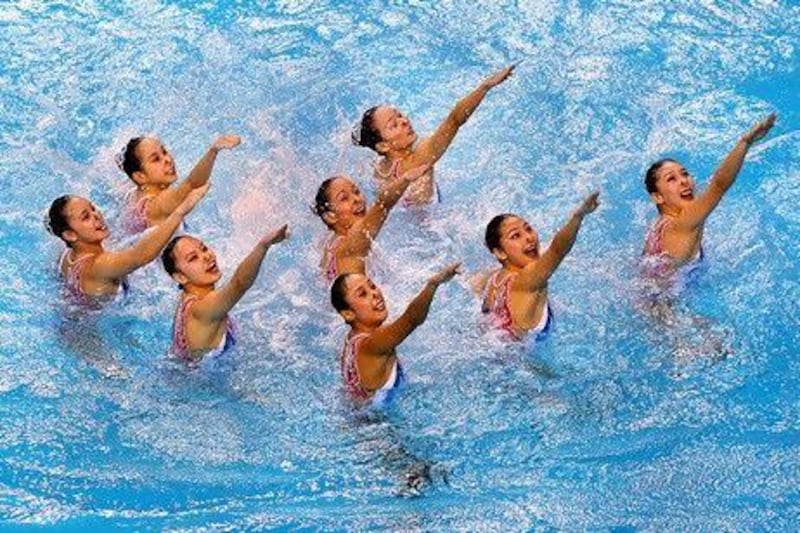Call it bizarre, call it beautiful, call it whatever you like, but there is certainly something inherently watchable about the sport of synchronised swimming. Dedicated athletes caked in vampish make-up and wearing elaborate sequinned swimsuits, moving majestically in the water in rhythm to booming and climactic music: it proves hypnotic.
Over the past four days of the ninth Asian Swimming Championships at the Hamdan bin Mohammed bin Rashid Sports Complex in Dubai, 11 countries have taken part in a range of separate formats, from solo technical to team combination.
China, who finished second at the London Olympic Games behind Russia in the team free category, took the top step of the podium in all seven formats.
Strutting across the stage flamboyantly before entering the water simultaneously, it could be forgiven for assuming the athletes are merely experts in a theatrical, aquatic art form.
Yet when tested and compared with other Olympic athletes, results found synchronised swimmers rank second only to long-distance runners in terms of aerobic capacity.
Athletes are often required to hold their breaths for more than a minute as they perform a series of precise routines for up to five minutes. They are aided only by the use of an altogether unflattering nose clip and when their heads finally emerge from the water, rather than take a lung-filling gulp of air, they must maintain their smile - accentuated by the thick and garish make-up - to give the impression their meticulous performance is all rather undemanding.
In yesterday's team technical finals - a format in which a group of swimmers perform a set of predetermined elements in a specific order - China scored 93.8 out of 100. According to the judges, the performance was head and shoulders and pectorals and abdominals above the competition as North Korea, in second place, scored 84.2 with Kazakhstan further behind on 80.9.
Yet to an untrained eye - and there are many - the majority of the performances appeared as cohesive and congruent as the next.
"I don't know what is going on or what is good and bad, but I like it," said Rosemary Pimental, a Filipino spectator. "The girls are just so graceful."
Some of the organisers of this week's championships have turned temporary television commentators, providing English analysis to East Asian broadcasters. Although learning on their feet, they said they have quickly discovered how to differentiate - much like the 14 judges - between artistic impression and technical merit.
The Japanese duo of Aika Hakoyama and Yukiko Inui finished second in the duets free finals, a format in which two swimmers perform a choreographed routine that relies predominantly on the team's creativity and innovation. Inui said through a translator that she was very happy with her performance, but conceded preparation was not ideal.
In the two months running up to a major competition, each athlete can spend up to 10 hours in the water each day, practising and improving synchronicity. After August's Olympics, most nations rested and recharged. Inui said her team was more focused on next week's Fina meeting in Mexico, where the 2012 World Trophy will be contested.
"For this competition, we did not spend much time on things," she said, her head still coated in Knox, a protein-rich gelatin used to keep hair in place.
"We only had a short time, so a lot of the choreography was organised very quickly. This was the first time we had performed it, so we were a little bit nervous."
Fortunately for them, it appeared only the judges seemed to notice. The rest of those watching likely saw it for what it was: bizarre, beautiful and breathtaking.
Follow us
[ @SprtNationalUAE ]





